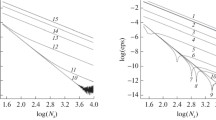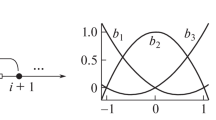Abstract
A new numerical method for solving the Cauchy problem for Hamiltonian systems is tested in detail as applied to two benchmark problems: the one-dimensional motion of a point particle in a cubic potential field and the Kepler problem. The global properties of the resulting approximate solutions, such as symplecticity, time reversibility, total energy conservation, and the accuracy of numerical solutions to the Kepler problem are investigated. The proposed numerical method is compared with three-stage symmetric symplectic Runge–Kutta methods, the discrete gradient method, and nested implicit Runge–Kutta methods.









Similar content being viewed by others
REFERENCES
M. P. Allen and D. J. Tildesley, Computer Simulation of Liquids (Clarendon, Oxford, 1991).
Computational Molecular Dynamics: Challenges, Methods, Ideas, Ed. by P. Deuflhard, J. Hermans, B. Leimkuhler, et al., Lecture Notes in Computational Science and Engineering (Springer, Berlin, 1998), Vol. 4.
E. Hairer, C. Lubich, and G. Wanner, Geometric Numerical Integration (Springer, Berlin, 2006).
E. Hairer, S. P. Nørsett, and G. Wanner, Solving Ordinary Differential Equations. I: Nonstiff Problems, 2nd revised ed. (Springer, Berlin, 1993).
L. D. Landau and E. M. Lifshitz, Mechanics (Fizmatlit, Moscow, 1965; Butterworth-Heinemann, Oxford, 1976).
F. M. Lasagni, “Canonical Runge–Kutta methods,” J. Appl. Math. Phys. (ZAMM) 39 (6), 952–953 (1988).
J. M. Sanz-Serna, “Runge–Kutta schemes for Hamiltonian systems,” BIT 28 (4), 877–883 (1988).
Yu. B. Suris, “Symplectic structure preservation in the numerical solution of Hamiltonian systems,” in Numerical Solution of Ordinary Differential Equations (Inst. Prikl. Mat. Akad. Nauk SSSR, Moscow, 1988), pp. 148–160 [in Russian].
G. G. Elenin and P. I. Shlyakhov, “On the conservativeness of two-stage symmetric-symplectic Runge–Kutta methods and the Störmer–Verlet method,” Differ. Equations 46 (7), 991–997 (2010).
L. Brugnano, F. Iavernaro, and D. Trigiante, “Energy and quadratic invariants-preserving integrators based upon gauss collocation formulas,” SIAM J. Numer. Anal. 50 (6), 2897–2916 (2012).
G. G. Elenin and P. A. Aleksandrov, “On the conservativeness of a two-parameter family of three-stage symmetric-symplectic Runge–Kutta methods,” Differ. Equations 48 (7), 965–974 (2012).
P. A. Aleksandrov and G. G. Elenin, “The possibility of constructing a conservative numerical method for the solution of the Cauchy problem for Hamiltonian systems based on two-stage symmetric symplectic Runge–Kutta methods,” Math. Models Comput. Simul. 7, 233–245 (2015).
G. G. Elenin and P. A. Aleksandrov, “Exact solutions of the resolving equations system for the family of symmetrically symplectic Runge–Kutta methods for the problem of a material point moving in a cubic potential field,” Preprint (MAKS, Moscow, 2011).
P. A. Aleksandrov and G. G. Elenin, “Total energy conservation at a step of the middle point method,” Preprint (MAKS, Moscow, 2012).
D. E. Okhotsimskii and Yu. G. Sikharulidze, Principles of Space Flight Theory (Nauka, Moscow, 1990) [in Russian].
W. Oewel and M. Sofrouniou, “Symplectic Runge–Kutta schemes II: Classification of symmetric methods,” Preprint (University of Paderborn, 1997).
G. G. Elenin and P. I. Shlyakhov, “The geometric stricture of the parameter space of the three-stage symplectic Runge–Kutta methods,” Math. Model. Comput. Simul. 3 (6), 680–689 (2011).
A. A. Samarskii and A. V. Gulin, Numerical Methods (Nauka, Moscow, 1989) [in Russian].
V. A. Trenogin, Functional Analysis, 4th ed. (Fizmatlit, Moscow, 2007) [in Russian].
N. S. Bakhvalov, N. P. Zhidkov, and G. M. Kobel’kov, Numerical Methods (Nauka, Moscow, 1987) [in Russian].
V. M. Verzhbitskii, Fundamentals of Numerical Methods, 2nd ed. (Vysshaya Shkola, Moscow, 2005) [in Russian].
M. Galassi, J. Davies, J. Theiler, et al., GNU Scientific Library Reference Manual, 3rd ed. (Network Theory, 2009).
D. E. Muller, “A method for solving algebraic equations using an automatic computer,” Math. Tables Other Aids Comput. 10 (5), 208–215 (1956).
J. Dennis, Jr., and R. Schnabel, Numerical Methods for Unconstrained Optimization and Nonlinear Equations (Prentice-Hall, Englewood Cliffs, 1983).
L. Fousse, G. Hanrot, V. Lefèvre, P. Pelissier, and P. Zimmermann, “MPFR: A multiple-precision binary floating-point library with correct rounding,” ACM Trans. Math. Software 33 (2) (2007).
G. Yu. Kulikov and S. K. Shindin, “Adaptive nested implicit Runge–Kutta formulas of Gauss type,” Appl. Numer. Math. 59 (3–4), 707–722 (2009).
G. Yu. Kulikov, “Automatic error control in the Gauss-type nested implicit Runge–Kutta formula of order 6,” Russ. J. Numer. Anal. Math. Model. 24 (2), 123–144 (2009).
G. Yu. Kulikov, G. Yu. Kulikov, “Embedded symmetric nested implicit Runge–Kutta methods of Gauss and Lobatto types for solving stiff ordinary differential equations and Hamiltonian systems,” Comput. Math. Math. Phys. 55 (6), 983–1003 (2015).
E. Hairer and C. J. Zbinden, “On conjugate-symplecticity of B-series integrators,” IMA J. Numer. Anal. 33 (1), 57–79 (2013).
R. Gerber, A. J. C. Bik, K. Smith and X. Tian, The Software Optimization Cookbook: High Performance Recipes for IA-32 Platforms, 2nd ed. (Intel, Santa Clara, 2005).
J. D. Hunter, “Matplotlib: A 2D graphics environment,” Comput. Sci. Eng. 9 (3), 90–95 (2007).
Author information
Authors and Affiliations
Corresponding authors
Additional information
Translated by I. Ruzanova
Rights and permissions
About this article
Cite this article
Aleksandrov, P.A., Elenin, G.G. Testing a New Conservative Method for Solving the Cauchy Problem for Hamiltonian Systems on Test Problems. Comput. Math. and Math. Phys. 60, 1422–1444 (2020). https://doi.org/10.1134/S0965542520090031
Received:
Revised:
Accepted:
Published:
Issue Date:
DOI: https://doi.org/10.1134/S0965542520090031




